Issue 1: Our native marine species and habitats are under threat
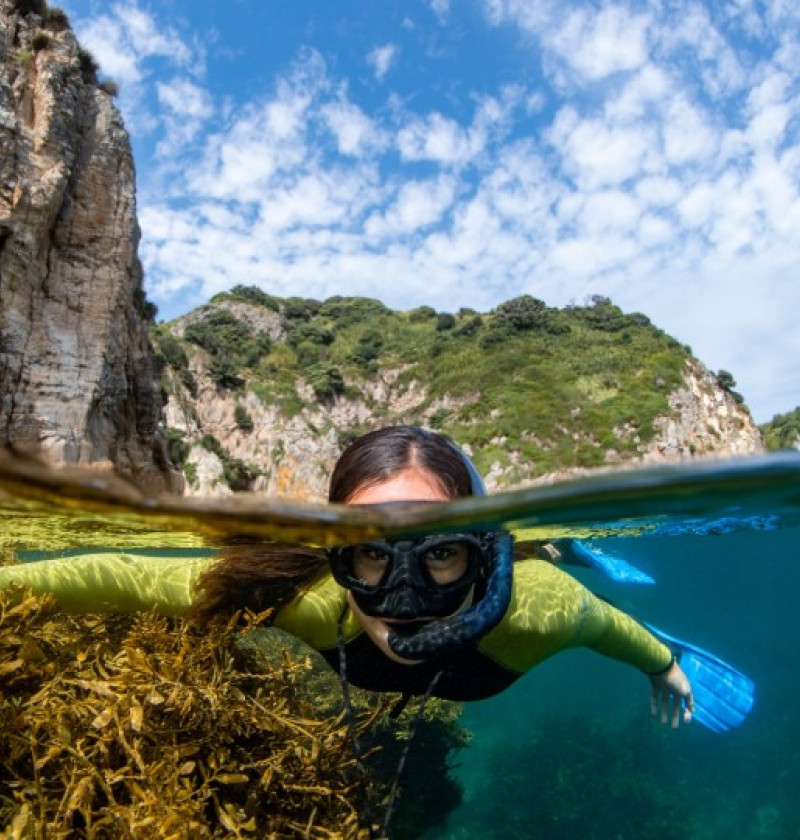

A diverse range of species and complex, healthy habitat can help ecosystems be more resilient to climate change and other disturbances. Many of our marine species are considered taonga – of cultural significance and importance to Māori.
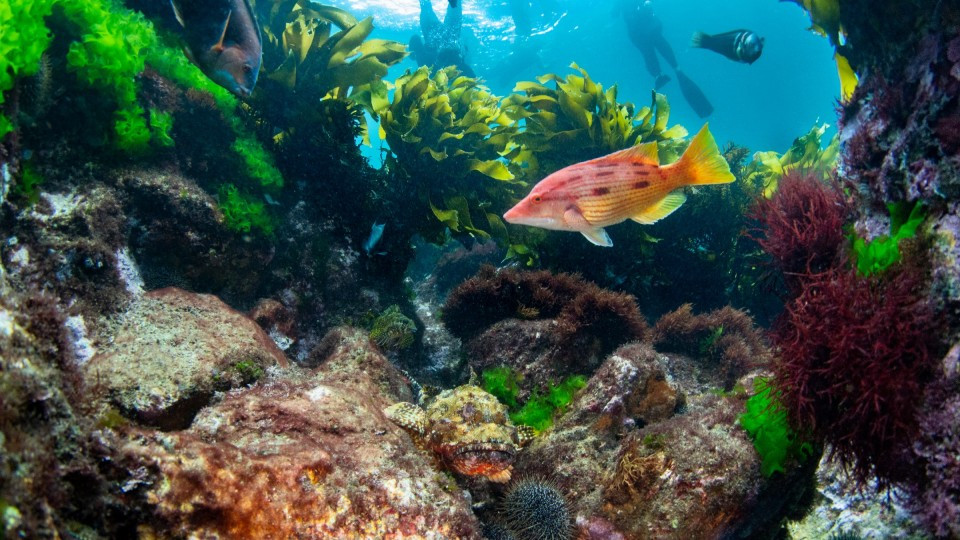
Image: Lorna Doogan, Experiencing Marine Reserves
Report focus: marine mammals, seabirds, shorebirds, non-native species (non-indigenous), and biogenic habitats.
All of New Zealand’s marine environments are affected. Many species face an increased risk of extinction and a reduced extent of habitats. Climate change will alter where many species are found.
There are major declines in habitat condition since European settlement. Some species are no longer found in the areas where they once lived.
Many changes are slow to reverse and some are irreversible. Only some habitats and species recover quickly from disturbance or depletion.
It can have significant impacts on our wellbeing, identity, and cultural values. Iwi relationships with rohe moana will be affected.
The conservation status of 675 native marine species has been established (figure 1), although this is only a fraction of the total number of species thought to exist in our marine environment (see indicator: Conservation status of indigenous marine species).
Nearly half of the world’s cetacean species (whales, dolphins, and porpoises) have been recorded in New Zealand waters (Gordon et al, 2010).
Based on the 2019 New Zealand assessment, 10 out of 45 (22.2 percent) assessed species of marine mammals are threatened with, or at risk of, extinction. The most threatened species are Māui dolphin, Bryde’s whale, southern elephant seal, and orca.
The conservation status of marine mammals was previously assessed in 2013. Since then, the status of southern right whale and the New Zealand sea lion have improved (table 2). For other marine mammals, there is insufficient data to determine with certainty whether the conservation status changed between 2013 and 2019.
Thirty assessed species of marine mammals are classified as data deficient (Baker et al, 2019). Knowledge about some species is growing, for example a new population of blue whale was recently identified in the Taranaki Bight (Barlow et al, 2018).
Seabirds are ranked the world’s most threatened birds by the International Union for Conservation of Nature (IUCN). Nearly a quarter of all seabird species breed in New Zealand and 10 percent only breed here (Croxall et al, 2012; Taylor, 2000). However, little information is available about their population numbers and breeding sites (Whitehead et al, 2019).
The most recent New Zealand conservation status assessment in 2016 found that 90 percent of seabirds and 80 percent of shorebirds were threatened with, or at risk of, extinction. Since 2012, two seabirds (Campbell Island mollymawk and yellow-eyed penguin/hoiho) declined in status, while two shorebirds (northern New Zealand dotterel and pied stilt/poaka) improved.
The New Zealand Threat Classification System (NZTCS) is used to assess the risk of extinction of New Zealand species. Not all native species are assessed because the available data is limited.
Expert panels determine the conservation threat status using population factors, including the number of breeding pairs, past and predicted changes in population, and pressure from human-induced effects.
Species can be:
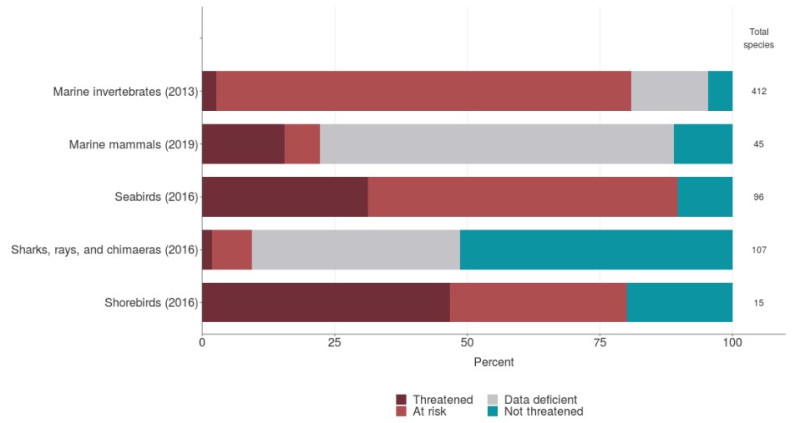
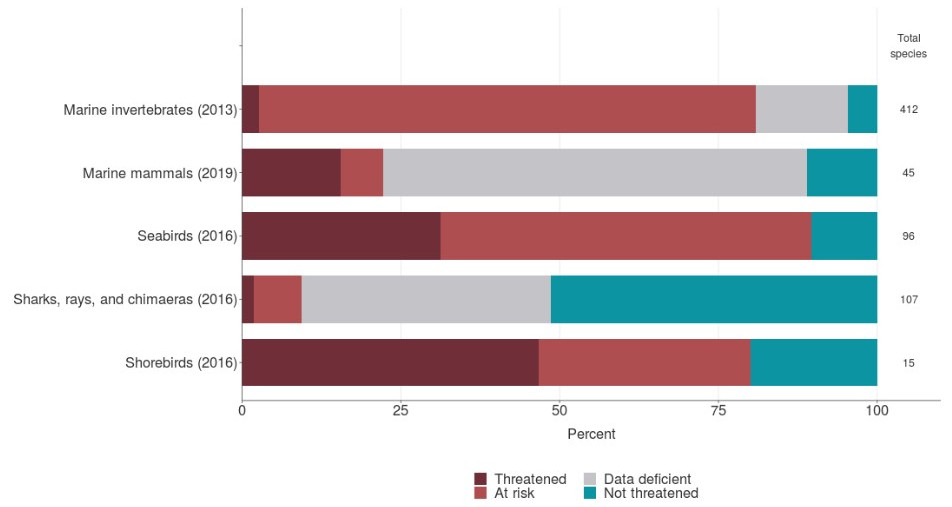
See accessible version of Figure 1 on StatsNZ website
| Species | 2013 assessment | 2019 assessment | Reason for change |
|---|---|---|---|
| Change in conservation status within the same threat category | |||
| New Zealand sea lion | Threatened (nationally critical) | Threatened (nationally vulnerable) | Actual improvement |
| Hector's dolphin | Threatened (nationally endangered) | Threatened (nationally vulnerable) | More knowledge |
| Change in threat category | |||
| Leopard seal | Non-resident native (vagrant) | At risk (naturally uncommon) | More knowledge – now known to live here |
| False killer whale | Not threatened | At risk (naturally uncommon) | More knowledge – now known to live here |
| Southern right whale | Threatened (nationally vulnerable) | At risk (recovering) | Actual improvement |
Note: A group of 18 taxa that had previously been assessed (5 Not Threatened, 6 Migrant and 7 Vagrant) are now listed as data deficient because the assessment panel agreed there was insufficient data to support the previous assessments.
Non-native, marine species are being introduced to New Zealand continually, usually carried by ballast water or on the hulls of ships (see Our marine environment 2016). Between 2010 and 2017, 43 percent of the non-native, marine species detected in New Zealand had established populations here and were living on permanent surfaces like rocks and piers (figure 2).
The number of established non-native, marine species has increased at a generally consistent rate since baseline surveys and a national review were completed in 2009. We now have 214 non-native, marine species living (and considered to be established) in our waters (see indicator: Marine non-indigenous species). Three more non-native marine species have established in New Zealand since Our marine environment 2016 was published.
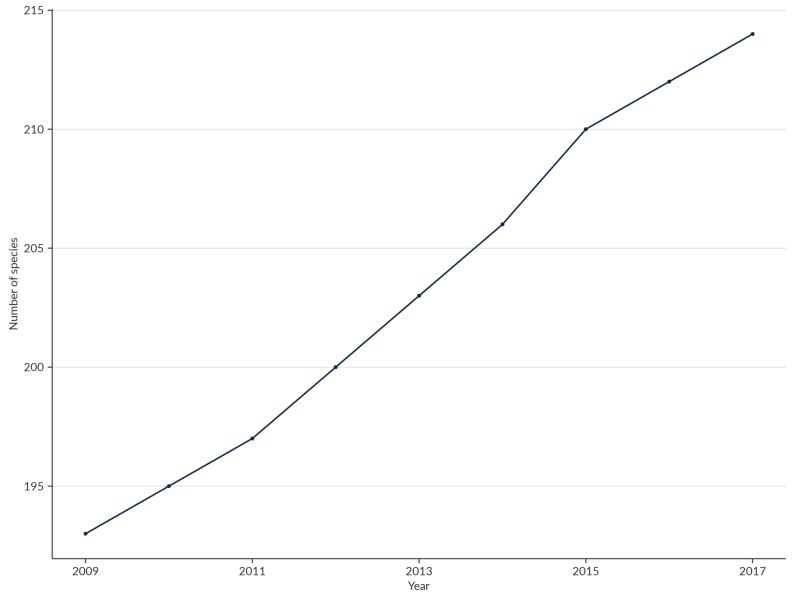
Image: Seaward & Inglis, 2018 (Data source)

Image: Seaward & Inglis, 2018 (Data source)
See accessible version of Figure 2 on StatsNZ website
Once established, some non-native, marine species can spread very quickly due to their tolerance to changing environmental conditions, fast growth rates, or other factors. For example:
In contrast to non-living habitats like rocks and sand, biogenic habitats are created by plants and animals. Biogenic habitats play a crucial role in enhancing biodiversity by providing ecosystem services. Examples of their benefits include a mussel bed providing shelter to juvenile fish or seagrass meadows removing and storing carbon dioxide from the atmosphere. Biogenic habitats, however, are vulnerable because they protrude from the seabed and are fragile.
The available data shows that, although some biogenic habitats are increasing in extent (mangroves for example), most are declining (table 3).
| Biogenic habitat | Examples of services provided | Distribution in New Zealand | Change in national extent | Confidence in data | Future prediction for national extent |
|---|---|---|---|---|---|
| Seagrass meadows | High primary productivity, nutrient cycling, nursery habitat provision | Widespread, particularly in estuaries and harbours | Decreasing | Good to moderate | Stable or increasing |
| Mangrove forests | Sediment trapping, erosion protection, wave buffering, habitat provision | Upper half of the North Island | Increasing | Good | Increasing |
| Kelp forests | Primary production, carbon sequestration, buffering waves, habitat provision, food, and refuges | Widespread, including offshore islands | Stable | Good | Stable (vulnerable) |
| Bryozoan thickets |
Carbon sequestration Habitat provision |
Widely dispersed | Decreasing | Moderate to low | Decreasing |
| Stony coral | Biodiversity hotspots in the deep ocean, habitat provision, nursery areas, and refuges for species | Widespread, particularly in deeper ocean and around offshore islands and seamounts | Stable or decreasing | Good to moderate | Stable or decreasing |
| Beds of large shellfish | Filtration, sediment management, nutrient processing, hard habitat provision (on otherwise soft sediments), nursery habitat provision | Widespread on coastline | Generally decreasing | Good to moderate | Generally decreasing |
| Calcareous tubeworm mounds | Biodiversity hotspots, habitat provision | As far north as the Hauraki Gulf to Stewart Island | Stable | Good | Stable or decreasing |
The scale of change and amount of habitat loss is a significant knowledge gap, due mainly to the cost of monitoring habitats (especially those that are under water). However, many organisations are mapping these habitats and the services they provide. A recent collaboration between Marlborough District Council, NIWA, and Land Information New Zealand found extensive but previously unknown kelp forests in Tory Channel (Marlborough District Council, nd).
Te Rūnanga o Ngāti Awa initiated repeated surveys of sub-tidal kuku reefs in Ōhiwa Harbour. It used data from mātauranga Māori interviews as the baseline for establishing their historical distribution and for further surveys. Two of the three traditional kuku beds on the eastern side of the harbour had gone. On the western side, a decline was observed from an estimated 112 million kuku in 2007 to 485,000 in 2016, representing an 88 percent decline in area. In 2009, 1.2 million pātangaroa (eleven-armed seastar), a significant predator of kuku, were also observed for the first time (Paul-Burke et al, 2018). The causes of these changes are not known.
An appreciation for the value that estuaries provide (see Estuaries: sensitive spaces that link land and sea) and our understanding of estuarine health is growing.
The changes and declines in our native species and habitats are not due to a single pressure and its effects, but the combination of:
These interactions can accelerate the degradation and loss of our native species and habitats (see All our activities put cumulative stress on the marine environment).
Further impacts on marine biodiversity and habitats are the result of historical activities, like the first conversions of land from native forest, early exploitation and localised depletion of coastal kaimoana, and the industrialisation of fishing. Many of these legacy impacts remain apparent today.
The mixing of fresh and salty water where rivers meet the sea makes estuaries dynamicecosystems. They contain species that thrive in these challenging conditions and can survive the changes wrought by tides, floods, and storms. Throughout history, these productive environments have been valued as sources of food.
Estuaries receive water, nutrients, and sediment from a whole catchment. In a healthy estuary, nutrients from the land are beneficial and enrich the environment for birds, fish, and other species. They also act as buffer zones and protect coastal areas from floods and storms.
Many activities take place around estuaries such as the provision of food (eg, fish and shellfish), recreation, and cultural practices (Thrush et al, 2013).
All the activities that take place upstream, including farming, forestry, and urban development, influence an estuary. Estuaries are able to trap and filter out pollutants in freshwater before it enters the ocean. However, if an estuary is overloaded with nutrients, sediment and pollutants, its health as well as its benefit to us, can be compromised (Thrush et al, 2013).
Mahinga kai (places where food is extracted or produced) is an important cultural health indicator for many hapū and iwi. A study of four estuaries in Canterbury (including Avon-Heathcote and Rakahuri-Saltwater Creek) found experienced shellfish harvesters changed their cultural practices when they noticed poorer environmental conditions (Kainamu-Murchie et al, (Ngāi Tahu), 2018).
A recent assessment of 48 lower North Island estuaries found some sites contained rare ecosystems and many supported high numbers of threatened and at-risk species. The 21 sites that were identified as having high restoration potential were less modified or had existing populations or fragments of habitat to build on (Todd et al, 2016).
New Zealand has more than 400 estuaries that are very different in their size, shape, and exposure to the sea (Hume et al, 2007). While some are overlooked or in a poor state, there are opportunities to maintain and enhance their health and value.
Lower levels of biodiversity can reduce an ecosystem’s resilience to pressures, including climate change (Oliver et al, 2015; Thrush et al, 2011). The decline of one species can also change interactions in food webs and cause cascading effects through an ecosystem.
One example is the relationship between kelp, kina, and snapper. Snapper eat kina, and kina eat kelp. Therefore, areas with low numbers of snapper can have more kina and less kelp, or be devoid of kelp (called kina barrens). This, in turn, affects the many species that depend on kelp for food and habitat (Shears & Babcock, 2002).
Healthy habitats are essential for healthy ecosystems. They provide food, refuge (especially for juveniles), and take up contaminants. If habitats are lost or degraded, the feeding, breeding, and migration behaviours of species are threatened. As well as direct impacts on species, the loss of biogenic habitats also results in the loss of wider ecosystem benefits (Sunday et al, 2017). Not all the consequences that habitat degradation can have on ecosystems are known.
Dense beds of shellfish filter water and hold sediment, contributing to improved water quality and providing habitat for other species. Kuku (green-lipped mussel) are common on coastal reefs, rocky shores, and mussel farms. Historically, they were also once a dominant habitat growing on soft sediments in areas like the Firth of Thames, Hauraki Gulf, and the Kaipara Harbour. By the end of the 1970s, they were considered mostly ecologically extinct from soft sediment environments and do not provide the same ecosystem benefits (Anderson et al, 2019). For example, an estimated 107 million mussels were lost in less than 10 years from a prized taonga bed in Okiwa Harbour in the Marlborough Sounds. About 500 square kilometres of kuku beds in the Firth of Thames were also lost (Anderson et al, 2019).
It has been estimated that with the historic coverage of mussel beds, the volume of the Firth could have been filtered in a single day. Current estimates are that remnant mussel beds take nearly two years to filter the same amount of water. Patches of kuku beds in the Bay of Plenty and the Hauraki Gulf supported invertebrate densities two to eight times higher than bare seabed and showed higher diversity of species (Mcleod, 2009).
Many species that are classified as threatened or at risk, are culturally significant to New Zealand and especially Māori (Ataria et al, 2018; Department of Conservation, nd).
Changes in marine biodiversity can affect how we value the ocean, and compromise the marine activities we enjoy like boating, fishing, and swimming (United Nations, 2016). The loss or decline of our iconic and taonga species can negatively affect traditional harvesting practices (mahinga kai) and the intergenerational transfer of mātauranga Māori and kaitiakitanga (Faulkner & Faulkner, 2017). In an analysis of 3,421 whakataukī (short phrases or proverbs that share intergenerational knowledge), 57 marine species were named. Koura (lobster), parāoa (sperm whale), ururoa (great white shark), and pipi were mentioned the most frequently (Whaanga et al, 2018). This illustrates an in-depth knowledge and connection with the marine environment.
Traditional ways of managing and protecting marine species and places for present and future generations could also be lost. This jeopardises the ability of communities to harvest species of traditional value and the ability to manaaki tangata.
Globally, traditional knowledge accumulated over tens of thousands of years and held by indigenous cultures is being forgotten. This includes important knowledge related to fishing methods, the uses of particular species like medicinal plants, and a vast array of spiritual and religious beliefs (United Nations Economic and Social Council, 2019).
Changes can also be costly. District councils, central government, industry, and tangata whenua spent more than $310,000 on managing the non-native Mediterranean fanworm at the top of the South Island alone during 2017 and 2018 (The Lawless Edge Ltd, 2018). Other non-native species could pose a threat to Marlborough’s aquaculture industry. Studies have estimated the potential economic impacts from the spread of the sea squirt Styela clava could reach $47.8 million per year (Goldson et al, 2015).
Loss or degradation of habitats can decrease the benefits we receive from marine habitats in our estuaries and oceans (Anderson et al, 2019; Diaz & Rosenberg, 2008; Thrush et al, 2001).
The benefits we receive from marine habitats are many and diverse but include:
There is insufficient data to quantify how much these benefits have changed over time.
Habitats provide services that go some way to mitigating the impacts of our activities, but this is finite. The interactions between species, and the interactions between species and the environment, are complex and cumulative. For example, mussels that are stressed by accumulated sediment may be more susceptible to competition from other species.
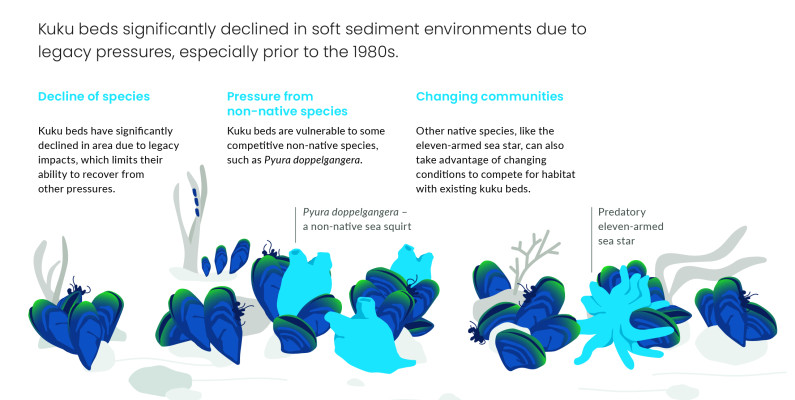
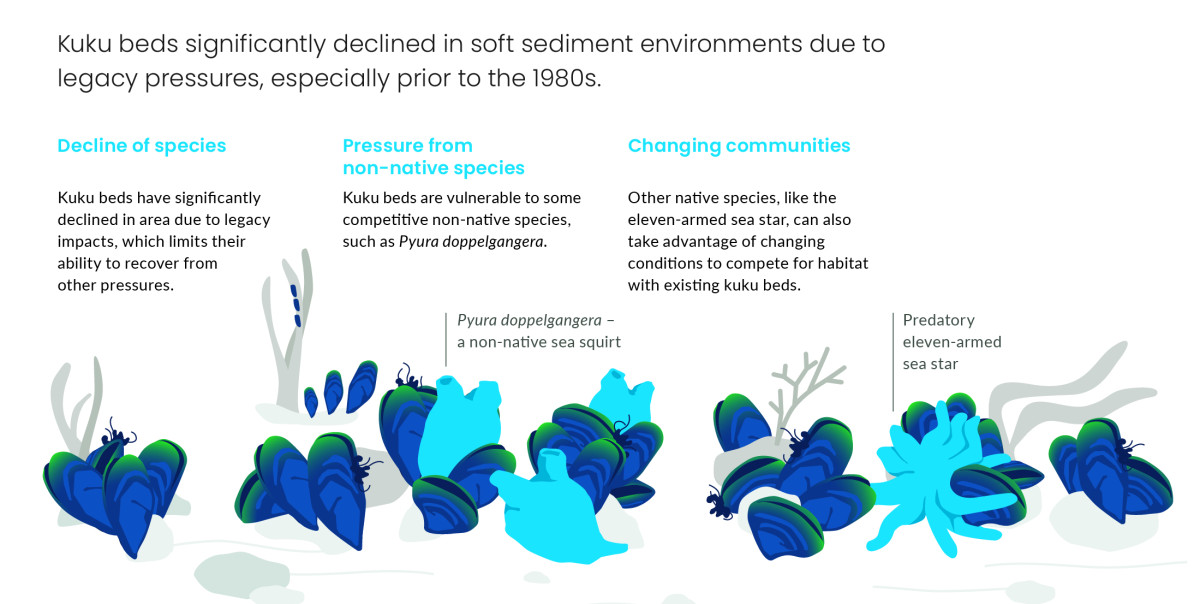
Read the long description for How ecosystem pressures affect kuku
Kuku beds significantly declined in soft sediment environments due to legacy pressures, especially prior to the 1980s.
Decline of species - Kuku beds have significantly declined in area due to legacy impacts, which limits their ability to recover from other pressures.
Pressure from non-native species - Kuku beds are vulnerable to some competitive non-native species, such as Pyura doppelgangera.
Changing communities - Other native species, like the eleven-armed sea star, can also take advantage of changing conditions to compete for habitat with existing kuku beds.

Issue 1: Our native marine species and habitats are under threat
October 2019
© Ministry for the Environment